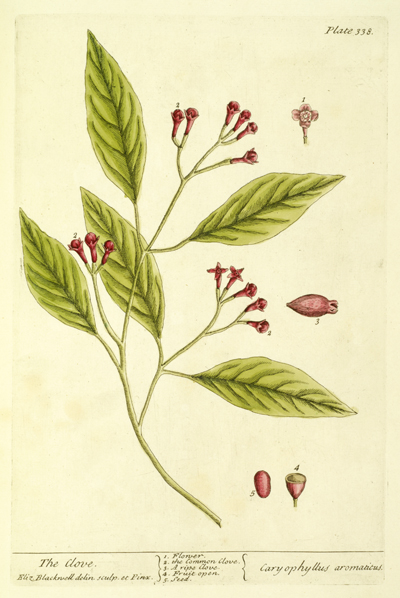
Dried cloves. [From Wikipedia] |
Cloves are the unopened flower buds of the clove tree. An evergreen native to Indonesia and India that grows from eight to twelve meters in height, the clove tree produces flower buds in clusters that are pale in color at first, become green, and then bright red, when they are ready for harvesting. Dried cloves are brown, hard, and nail-like in shape. The English name derives from the Latin clavus (nail); the French word for nail is clou. |
| As a spice, in whole or powder form, cloves are used in cuisines all around the world. They are also used as a food preservative. One has to think only of a ham garnished with whole cloves to realize how ubiquitous and versatile the use of the spice has become. The clove scent is common to perfumes, and using cloves in oranges as a decorative pomander is a popular European tradition during the Christmas holiday season. Clove oil has both antiseptic and anesthetic properties; for example, it has been used in treating toothache for centuries. While many Asian countries have developed numerous therapeutic uses for the spice, Western culture has generally underrated its potential as a herbal remedy. (Note, though, some of the early eighteenth-century medicinal uses in England in Elizabeth Blackwell’s description below.)

Blackwell’s description:
- The Trunk of this Tree grows about the Bigness of a Man’s Waist, the Leaves resemble those of ye Bay, in shape size and Colour; the Flower is red, and the Seed a reddish Brown.
- It grows in the Molucca Islands, in the East Indies; and this Specimen was taken from a Branch of the Tree at Sr. Hans Sloan’s. [Sir Hans Sloane, 1660–1753, was a British physician whose natural history collection became a foundation of the British Museum.]
- Cloves are esteem’d healing, drying, cordial, cephalic and Stomatic; being good to stop Vomiting, strengthen a weak Stomach, expel Wind, prevent Fainting and malignant Distemper. The Distill’d Oyl is said to cure the Tooth-Ach, a Bit of Line being dipp’d in it, and put into the Hollow Tooth.
- Greek, Καρυόφυλλον. Latin, Caryophyllus. Spanish, Clavos. Italian, Garofoli. French, Girofle. German, Negelen. Dutch, Negelein.
|

Elizabeth Blackwell, “The Clove, Carophyllus aromaticus.” Plate 338 from volume 2 of Blackwell’s A Curious Herbal, Containing Five Hundred Cuts, of the Most Useful Plants, Which Are Now Used in the Practice of Physic: . . . To Which Is Added a Short Description of Ye Plants; and Their Common Uses in Physic (London, 1739). [Rare Books Division] |
| A Curious Herbal is a large, two-volume work with gloriously colored plates, by Blackwell’s own hand, which she painstakingly achieved over several years while Alexander, her physician husband, languished in debtors’ prison. (She would bring him the completed plates, and he would supply some medicinal information, including the plants’ names, in Latin, Spanish, Italian, French, German, and Dutch.) In fact, she had begun the work in an effort to raise funds to free him—and ultimately succeeded. Alexander later became court physician to Frederick I of Sweden, where the couple had gone to start a new life. But he got involved in diplomatic intrigue, was convicted of conspiracy against the crown, and was decapitated in 1747. Little is known of what became of Elizabeth Blackwell after her husband’s execution, but her plates are a testament to something lasting and beautiful. |


